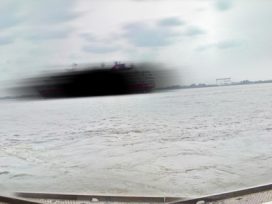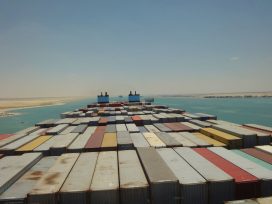I know nothing more imposing than the view which the Thames offers during the ascent from the sea to London Bridge. The masses of buildings, the wharves on both sides, especially from Woolwich upwards, the countless ships along both shores, crowding ever closer and closer together, until, at last, only a narrow passage remains in the middle of the river, a passage through which hundreds of steamers shoot by one another; all this is so vast, so impressive, that a man cannot collect himself, but is lost in the marvel of England’s greatness before he sets foot upon English soil. It is only later that the traveller appreciates the human suffering that has made all this possible.
Since Engel’s wrote these words, what has history washed away from the water and banks of London’s river, the canals that fed off and into it? In Engels’ time, the river in London was already the site of a disappearance, a shift from one phase of maritime transport to another – that is, from one phase of technical development and capital accumulation to another. Engels remarks in a note that, “in so far as such ships still ply to and from London they are now to be found only in the docks, while the river itself is covered with ugly, sooty steamers.” Today, from the centre of the city, what little traffic can be seen is largely of a leisure variety, though high-speed water buses decorated in Damien Hirst’s signature coloured dots do transport commuters to work as well as tourists to service and sightseeing hubs.
As the global media spotlight descends on London for the 2012 Olympics, taking place in the turbulent wake of a financial crisis which has since become a “Euro crisis”, this article will argue, perhaps counter-intuitively, that London’s relationship to water and to the sea remains central to its role in the global economy and vital to a gamble (in which the Olympics play a major part) to retain the advantage in rapidly changing conditions.
The box that shrunk the world
To understand the apparent absence of commercial traffic on the Thames, one needs to understand a crucial tool of the globalisation of world trade – the shipping container. This standardized aluminium or steel box, a simple thing in itself, has helped integrate East Asia into a world economy, has made thousands if not millions of dock workers redundant, has shifted power from manufacturers to retailers and has dramatically changed both how and where goods are manufactured and distributed. The ports through which eighteenth, nineteenth and early twentieth century maritime trade moved, such as Liverpool, New York and London, have almost ceased to be ports at all – shifting all cargo activity beyond their city borders – whilst new centres such as Shenzhen and Felixstowe have built vast facilities to accommodate this new, modular means of transport.
The container has served not only to reduce the number of hands through which goods need to pass, by integrating fewer workers as appendages to powerful cranes, but has also restructured the manufacture, storage and sale of goods. “The container,” writes Marc Levinson, “is at the core of a highly automated system for moving goods from anywhere, to anywhere, with a minimum of cost and complication on the way.” Containerization most accurately reflects the commodity form under capitalism: discreet units of value travel along a vast automated supply chain, tracked by computers and RFID chips with elements of the labour process being added along the way, as part of a networked “factory without walls”.
The dock of history
The container brought with it a very different set of requirements to those previously met by the concentrated pool of urban workers living in close proximity to the harbours, warehouses and factories of nineteenth century harbour cities, and was thus a major factor in their re-shaping and “rationalization” from the mid-twentieth century onwards. In 1951, the Port of London was the second largest docks in the world. Although there were already those who argued that the docks and the extensive canal traffic that served it should be wound down, due to the impossibility of getting larger ships up the Thames, containerization played a pivotal role in the transformation in the Port of London’s fortunes.
It was no coincidence that London’s docks had historically contained some of the most militant unions and labour organizations. The container was central to breaking the power of organized labour, dramatically reducing labour costs and establishing a new casualized and atomized workforce integrated into a high-tech globally competitive transport infrastructure. The testing ground for the introduction of containerization into the Port of London in the early 1960s took place on what is now part of the “Stratford City” site – a retail and housing development correlate to the London 2012 Olympics. The introduction of containers into the Port of London was, needless to say, not welcomed by the well-organized labour force whose ancestors many credit with inventing the term to strike. A series of strikes by London dockers throughout the 1960s came to a head in 1972, when 35,000 dockers turned out on an strike throughout the UK in protest at the arrest of three pickets at the Chobham Farm container base (a goods yard behind Stratford “International” train station, which now serves the entrance to the Olympic site).

The protests strikes spiralled from a defensive campaign to protect jobs into one the largest actions by organized labour since the 1926 General Strike, involving the successful picketing of national newspapers and eventual release of the jailed dockers. Alongside major strikes by railway workers and miners, the strike proved the strength of the unions in the UK at the time, effectively bringing down Edward Heath’s government in 1974 and resulting in a successful leadership challenge within the Conservative Party by Margaret Thatcher in 1975. During the 1972 dockers strike, goods traffic was re-routed via the new port of Felixstowe and other ports on the South East coast. Though the strike proved a defeat for the government, during the 1970s and 1980s traffic through the Port of London moved downriver or shifted to the expanding facilities on the south east coast. Felixstowe grew exponentially with the growth of container traffic in the 2000s, becoming the sixth biggest container port in Europe in 2005.
What is the significance of the proximity of this historic site, Chobham Farm, to the present Olympic Park in Stratford? The London 2012 Olympics take advantage of the connections that are the legacy of a Victorian industrial transport hub. The Lower Lea Valley, of which Stratford is a part, is at the centre of a confluence of road, canal, sewage and railway networks that connects the Thames and the former London docks with Kings Cross, St Pancras and Liverpool Street stations, along with more recent additions: New Spitalfields Wholesale market, the Docklands Light Railway, Eurostar and the M11 and M25 motorways. While the area surrounding Stratford acquired, by compulsory purchase order, for the Olympic Park was in many ways a classic post-industrial wasteland, many accounts of its recent transformation have emphasized the symbolic role of the Olympics as the post-Fordist nail in the coffin, paving the way to a service economy focused on leisure, luxury consumption and real estate markets. In fact, underneath the jingoistic fanfare of the games and fading shimmer of London’s “creative industries”, a stealth re-industrialization is taking root. The Olympic site connects the old financial centre of the City of London with the new financial centre in London Docklands, Stratford’s Olympic zone and a corridor of transport infrastructure feeding into the city from the South East.
Regeneration games
As early as 1951, the docks’ potential was being seen less as place of work than as scene of leisure and conspicuous consumption. The displacement of industry from the river and canalside was initially justified in terms of the twin evils of blight and pollution, which were to be cured by the virtues of parks, open space and picturesque views. In 1951, 85.1 per cent of the riverside below Blackfriars Bridge was used for industrial and commercial uses. Now, at least the same percentage is occupied by luxury apartments. The shift is symptomatic of the neoliberal agenda adopted in Britain the 1970s, the flagship for which was the London Docklands – enacting a form of geographical revenge upon workers in both newsprint and docking industries. Engineered under a novel form of quasi-governmental organization, the London Docklands Development Corporation, private and state interests entered into a new synchronicity as planning laws were suspended, land was remediated at the expense of the state, taxes breaks shared out and new by-laws invented. In the course of this development, Rupert Murdoch effectively sacked 6000 workers from his workforce overnight and moved the entire News International media business to a secure compound in Wapping. The result was to assure an effective private global island-on-Thames, ruled by the worlds’ finance, insurance, media and real estate corporations.

Despite encountering vast opposition from the local population, many of whom were former dock-workers, and being completed just after the Stock Market crash of 1987 (the landmark development Canary Wharf came close to bankruptcy in 1992), the London Docklands effectively showed that mega-projects could re-shape not only the city fabric, but also social relations. This development would not only affect the river, canals and former docklands, it was symptomatic of a broader shift across the UK to a services-based economy and a built environment that would both reflect and engineer that shift. As Iain Sinclair, long-time observer and critic of the transformation of London’s East End, has put it:
[Regeneration] seems to travel along water, canal systems, sewers, ditches, anything… As long as there’s a glimpse of water the developers will whack it into their prospectus and there’ll be photographs of water and parks. Regardless of what else is there they just take over all the industrial premises and come up with more and more New York loft-living style tackily built hutches. What was once very marginal and off the map seems to have become central to the arguments of the city at the moment.
Reshaping the material fabric of the city and its class relations, “regeneration” seeks to smooth the passage of capital investment, pooling liquidity and creating ease of access to state funds and resources in a form of “capitalist commoning”. As part of the same movement, disinvestment or divestment occurs as publicly owned resources are sold off or broken up to suit the interests of this movement of privatization. This might take the form of direct transfer of wealth to the private sphere, of a sell off, a land grab, or theft, or the mechanism of debt is used to bind the state into a relationship of dependency upon the private interests of the market. Legislation and para-legal apparatus punish recalcitrance or non-compliance with the new regimes of the deregulated labour market being put in place.

Along the south side of the river visible from the part of the river closest to where I live, between warehouses long ago converted into luxury housing units with panoramic views, there is a public park affording rare access to the river. In this park there stands a sign that invokes a local by-law prohibiting public drinking and the use of barbecues. Canary Wharf towers over this park-cum-enclosure, representing a privatized island, a business park containing buildings modelled like glass credit cards. Observing the spectacle, I recall the voice of Marlow, Joseph Conrad’s narrator in Heart of Darkness, ruminating over the continuous traffic of empire that has flowed past that point:
Hunters for gold or pursuers of fame, they all had gone out on that stream, bearing the sword, and often the torch, messengers of the might within the land, bearers of a spark from the sacred fire. What greatness had not floated on the ebb of that river into the mystery of an unknown earth! […] The dreams of men, the seeds of commonwealths, the germs of empires.
Both Conrad’s and Engels’ narratives relate the river as the carrier of history as well as of goods and men. While Engels sees the river as a picturesque space increasingly crowded and obscured by the expansion of industry, Conrad evokes “the great spirit of the past upon the lower reaches of the Thames” to render history as one long catastrophe of brutality and conquest. Moored in a ship on the Thames off Gravesend, Marlow states suddenly “And this also, […] has been one of the dark places of the earth.” The river Thames also reverses the image of Enlightenment’s outflow from the centre of civilization.
Culture of containment
At this point the story perhaps requires complication, since the backdrop of the spectacle of the 2012 Olympics and its skirting of retail and residential speculation is in fact a vast and stealthy new re-industrialization of sorts. Despite the desire to relegate these dynamics to history, there is increasing evidence to assert connections between shipping, logistics and the hi-speed, only apparently immaterial, world of finance.
As Levinson writes, containerization “greatly increased the range of goods that can be manufactured economically at a distance from where they are consumed, the distances across which those products can feasibly be shipped, the punctuality with which that movement occurs, and the ability of manufacturers to combine inputs from widely dispersed sources to make finished products.”
Effectively, containerization has proved an accomplice to the deterritorializing dynamics of finance, the two processes acting in concert to facilitate a common movement and rhythm. Containerization drives down the cost of distribution but also the price of labour – when goods can as easily be made in the US or China, the lower of the two wages acts to depress the higher. Moreover, the dramatic expansion of choice of goods and the lowering of their price has helped hold wages down in the West. While finance seeks profitable investment, forcing firms into competition for higher productivity, containerization effectively makes sure this competition is global and the labour that produces for it on demand.
The photographer Allan Sekula is among a small but growing number of critical commentators who have turned with increasing scrutiny to this apparently marginal and obscured vast global network of goods. In his recent film with Noel Birch, The Forgotten Sea, the narrator intones:
Ships now resemble floating warehouses plying fixed routes between producing countries and consuming countries, whilst factories become ship-like, stealing away in the dead of night in search of cheap labour.
Sekula has effectively tracked how containerization’s transformation of space – both sea and land – is flattened, smoothed out, tuned to the abstract flows of money that commands the flow of goods. In his book Fish Story, he writes:
What one sees in the harbour is the concrete movement of goods. […] If the stock market is the site in which the abstract character of money rules, the harbour is the site in which material goods appear in bulk, in the very flux of exchange. […] But the more regularized, literally containerized, the movement of goods in harbours, that is, the more rationalised and automated, the more the harbour comes to resemble the stock market.
Still, we might wish to challenge Sekula’s simplistic division between “producing and consuming countries”. His own film attests to the fact that 60 per cent of goods exported from China are manufactured by US owned companies. Certain post-crisis indications suggest that not only have certain core exports from the West – for example rice in the US and raw chemicals in the UK – remain stable, but they have often increased as the developing economies of the BRICS expand. As exports to Europe and the US wane, the developing industrial economies of China and India try desperately to take up the slack by develop internal consumer markets. With wages stagnant or declining in the UK and the drastic fall in the value of the pound since 2008, British economists are beginning to discuss opportunities for export to these emerging consumer markets in the East. Though such arguments have thus far appeared ludicrous in the face of the global balance of trade and the devastation of the UK’s industrial base, there are mounting reasons for granting them some credibility.
If we relate to the sea and its history only through the commodities which travel the world in order for us to consume them, then this isn’t because there is any less traffic. In fact, with the rise of container, the logistics industry, and shipping as part of it has expanded manifold times. In the UK, port traffic exports increased fivefold between 1965 and 1994. Until recently the Port of London Authority (which has jurisdiction over the entire Thames estuary) had the largest traffic in the UK (52.7 million tonnes in 2007). In 2010, despite a fall in global maritime freight since the 2008 economic crisis, the Port of London showed signs of recovery, increasing freight traffic by nearly 3 million tonnes between 2009 and 2010, making it the second largest port in the UK by weight. Yet, due to the slow speed and distance from London itself, this immense activity remains largely invisible.
The growth of London as a centre of finance during the 1990s and the boostering of an attendant “creative sector” actually masks the fact that the UK’s balance of trade is still sustained by manufactured exports. As Patrick Keiller has noted, “the service sector’s share of exports has actually declined since 1960, and imports of cars, electronics and other visible items are balanced by exports not of services, but of less visible manufactured items, in particular intermediate products (for example, chemicals) and capital goods (power stations, airports, weapons).” Connecting the manufacturing sector of the London area to rapidly developing logistical hubs on the south east coast is the vast transport infrastructure lying below and behind the London Olympics site.
A number of new developments in the Thames Gateway, the most significant of these being the London Gateway, a deep water container port at the outer reaches of the Thames Estuary, will open in 2013. The site is being developed by DP World, the third largest port operator in the world, based in Dubai. The London Gateway will be designed to accommodate the next generation of container vessels and feature its own dedicated rail terminal. Press for the new port and logistics park balances hopes for the creation of 36,000 new jobs with the promise of higher productivity and efficiency gains for UK businesses.
All the while, labour is squeezed out by this ever increasing technical composition of capital. But it is also made remote, divided and furtive by the race to the bottom for cheaper material costs and lower wages. Capitalist competition takes the form of a centralization of profits (paper claims on wealth) in those glass towers that tower over our cities and an almost subterranean distribution of labour – the life-spring of production – now perversely invisible and outcast.
This dynamic – the banishment of labour by capital – is played out in London as a de-urbanization of the working poor. Driven by the massive privatization of public housing and house price inflation, the corollary of London’s emergence as a financial centre, the mounting housing crisis has been exacerbated by government measures to ensure central London remains exclusive, and by outer-lying local councils shifting tenants out of London to make space for the Olympics. This has conspired to produce a situation in which large numbers of workers living in one of the poorest of London’s five Olympic boroughs were recently “discovered” to be paying exorbitant rents for the privilege of living in sheds at the backs of gardens. Perversely, a low-waged flexible working class is exactly what capital accumulation London-style needs, but there are numerous signs (the recent student protests and August 2011’s riots) that the new conditions offered are less than acceptable. Most of the targets of the 2011 riots were exactly the firms – Lidl, Tesco, Curries, T-Mobile, JD Sports – that thrive on the global division of labour: low waged staff both in store and all the way back along the supply chain. It seems that the whole reproduction of this cycle of ever lower wages and ever higher profits are meeting their nadir – the point at which a crucial component in the chain snaps.
Slaves to the rhythm
During Queen Elizabeth II’s Jubilee celebrations, Grace Jones provided a fitting tribute to the capital’s 15 million workers. Dressed as an Amazonian Britannia, she sung “Slave to the Rhythm” whilst keeping up, in multi-tasking virtuoso-style, a hula hoop around her waist. The song is appropriate not only because “chain gang” references struck a chord with the intense working culture pervasive in the UK’s capital. But, as we found out the following day, Grace’s tribute connected directly with the new measures rapidly being introduced to maintain the status quo our queen rules over. The central pageant organized to celebrate the Jubilee was a flotilla made up of diverse historic vessels travelling up the Thames, evoking the rich history of London’s river and, more anachronistically, the D-Day Normandy landings. Amongst the vast security staff employed to steward and secure the jubilee were a number of unemployed benefit claimants, coerced to work the whole weekend unpaid, sleeping in coaches and changing clothes under bridges, in order to complete a “trial” for supposedly well-paid contracts being offered to work at the 2012 London Olympics. This so-called “workfare”, being rapidly rolled out across the country, connects closely to ambitions to adjust the UK’s trade balance in favour of exports, by shackling a new transport infrastructure to reduced labour costs.
It will remain to be seen whether neo-Victorian conditions in the capital will successfully force London’s low-wage workers out of the city and into the gaps between the expanding supply-chain forming around it. Nevertheless, the efforts to “recapitalize” the poor and bring both production and labour costs into line with a globalized minimum should be taken seriously. Though the endo-colonial invasion of East London has until now been the primary focus of much criticism, the global dimension of the influx of investment and the sheer depth of the restructuring of which it is a part tends to go unremarked. A recent scandal helps draw our attention to this reality. The most prominent monument encrusting the Olympic site is the ArcelorMittal Orbit tower. The 115 metre high observation platform is a collaboration between artist Anish Kapoor, designer Cecil Balmond and Indian-born steel tycoon Lakshmi Mittal, who funded the commission to the tune of 16 million pounds and provided much of the steel. Mittal is the owner of a network of iron ore mining and steel production plants that stretches from Luxemburg to South Africa. His success has been built on controversial acquisitions of privatized state industries, particularly in the former communist East, and the enormous demand for steel from the emergent Indian and Chinese economies. Alongside its history of labour disputes and protests against polluting plants, ArcelorMittal’s empire now has had to contend with controversy at it’s mine in Omarska, Bosnia – the site of a former Serbian concentration camp in 1992 and potentially the graves of over 3000 missing persons.

Until now, ArcelorMittal has failed to conduct either an investigation of the site or erect a memorial in Omarska that the survivors and their families would like to see. The global circuit of labour, iron ore and profit extraction which the ArcelorMittal Orbit tower unintentionally allegorizes is now subjected to an appropriation from below, as survivors of the camp recently visited the London Olympic Park to nominate the Orbit as the Omarska Memorial in Exile.
It is telling that the inconvenient side effects of the otherwise smooth globalized accumulation of wealth come home to London at a time when the world’s gaze falls upon the city, whose uneven distribution of wealth and blatant inequality passes for hyper-modernity. At the 2012 Olympics, cultural containment meets the culture of containerization. It becomes ever clearer that the games are less a celebration of the people who make London a world city and more an attempt to ruthlessly fashion secure connections that continue to draw in the wealth of the rest of the world. Here, despite these pressures, hope in being connected differently has not quite yet ebbed from those who have come from far and wide to reside by the banks of its great river.











